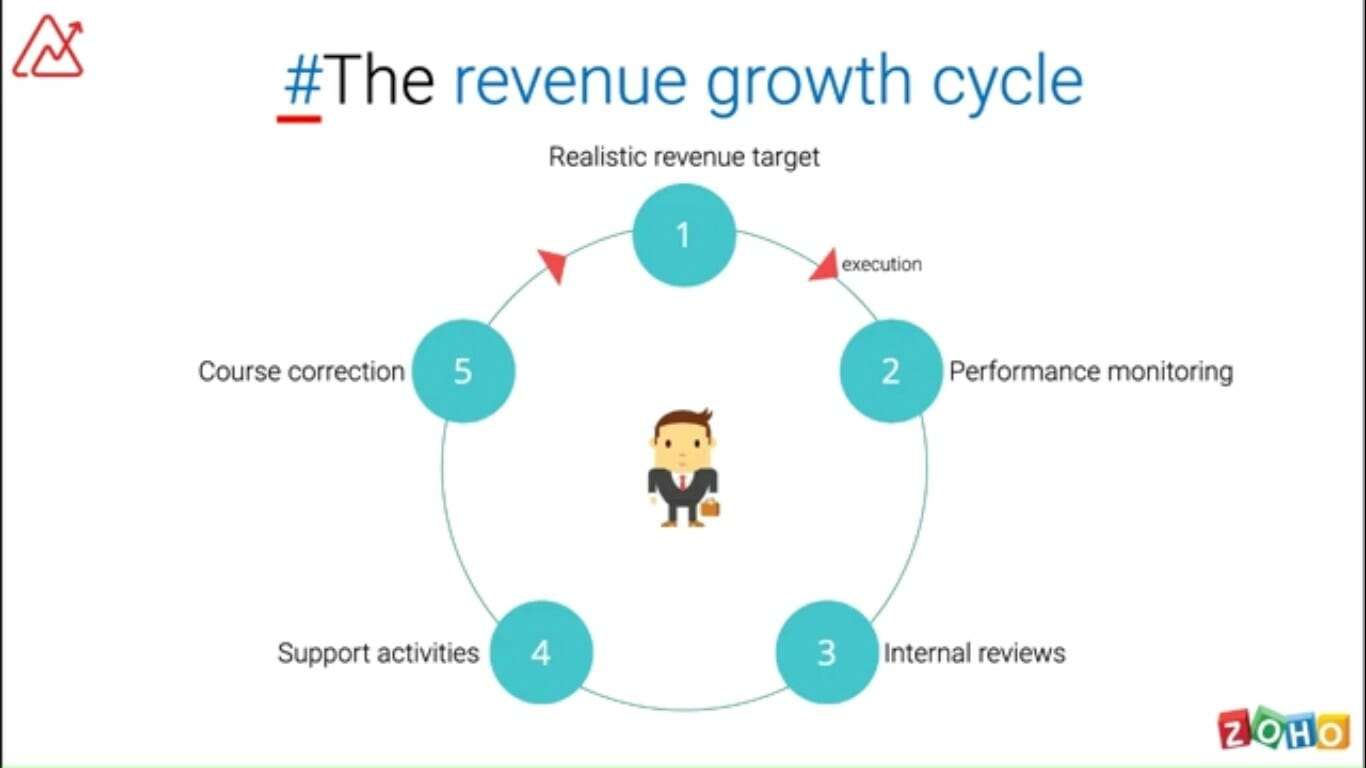The Revenue Growth Cycle
Neither of us can wave a magic wand to drive revenue growth, as analytics is a continuous step-by-step process. The revenue growth cycle is one such model that talks about the five essential steps to drive revenue growth in any organization. The revenue growth cycle starts by setting a realistic revenue target for your team and for your organization. Once you’re done setting the targets, the execution cycle kicks in, followed by where you begin to monitor the performance of your teams. After that, you get monitored through internal reviews in the revenue growth cycle. Step four is all about introspecting the effectiveness of your supporting activities. Finally, you lay down a course correction to help you align your activities to achieve the desired revenue growth.

Now, most organizations have different approaches to driving revenue. However, they are highly likely to fall into the same or a similar model. The revenue growth cycle is a continuous process. Most organizations would have by now established a sales process, set up a sales team, defined the roles and responsibilities, identifying the training needs, and all that’s necessary to keep sales up and running.
To understand how sales analytics, in particular, drives revenue growth in this framework, we are going to pick the most important question in each of these five stages.
Setting A Realistic Revenue Target
Zoho analytics can help the sales manager and their bosses forecast sales figures to define realistic sales targets. Precise sales forecasting can annul these differences and help a sales manager and the boss see through the same lens.
Performance Mark Monitoring
How is my sales team performing? The minute a sales manager asks the team about their performance, they may hear things like the markets are down, the pricing is an issue, competition is pretty stiff, very difficult to fight through, and the customers are not responding. That creates a very hazy picture of the ground reality for a sales manager. What if there was a way to get some fine-grained team performance reports that can help a sales manager work alongside a team in guiding them towards achieving sales goals.
How do we build these sales performance reports that are going to help the sales manager assess the team’s performance effectively? With analytics, you can come up with a sales team performance report that’s going to help a sales manager precisely monitor the sales team’s performance. They can also align activities in case it is needed to help the team achieve their sales goals. Analytics also provides the facility to monitor performance in a versatile way. You can also add more KPIs to your report, and finally, it gives you a very objective outlook of assessing your sales team’s performance.
Internal Reviews
Internal reviews have become an essential part of salespersons’ life. Most people are thrown into chaotic situations where they hit the panic alarm on an internal review. With overwhelming data, how can you efficiently handle sales reviews? Essentially a sales manager needs to understand the data, the data relationship, and the data structure to help him answer these questions on the go.

With analytics, you can get an intelligent assistant who can seamlessly answer internal review questions? A sales manager can talk to this assistant in natural language to help them handle these internal reviews effectively. Zia is an intelligent assistant that is ai driven that empowers salespersons.
Supporting Activities
There’s been an age-old epic battle between the sales and marketing teams in the corporate sector. The question to ask yourself is, did the marketing activities really support me in achieving my sales numbers. Most times, the credits keep shifting between the sales and the marketing teams, but who has actually done the work in helping the sales team get the numbers. With analytics, you can create a vantage point to measure the effectiveness of these activities.
To translate that into technical parlance, what if I can fetch data from different ad platforms from my CRM application and also from my finance product and have them blend together in one powerful bi platform for precise analytics to understand the impact of one activity on the other.
With the blended dashboards, you’re able to understand the business impact of different variables. You need not restrict them to your marketing activities. They could also be your support tickets, and you get to understand the impact of the support tickets on your sale and more. You can also help your marketing team align the activities in helping you achieve your sales numbers, and you have a single all-in-one dashboard that gives you a holistic and detailed view of what’s happening within the sales team and the marketing team. Finally, it helps you build accountability within your team.
Course Correction
Where should I focus on reviving my sales numbers?
A sales manager has multiple territories and regions mapped to a sales basket. He has targets defined against different product categories and products. A sales manager has a fairly huge team of salespeople to manage. Finally, a sales manager has multiple sales promotion campaigns being executed under his supervision.
With all this in place, how will a sales manager ever get to know the area of focus unless a sales manager can drill down into finer details on the sales reports?
With the ability of our sales manager to drill down into finer details, a sales manager is able to pinpoint the problems in no time. That’s going to throw a lot of deeper hidden insights on the go. This is going to help the sales manager optimally utilize their time better. Instead of running around and having multiple discussions, they can drill down into these reports to pinpoint the problem. A typical CRM service might offer these reports, but they might be scattered and lying in different places. You might have to understand the correlation between these reports. A powerful, bi platform will help you drill down into these specific KPIs in trying to understand and fix these problems.




